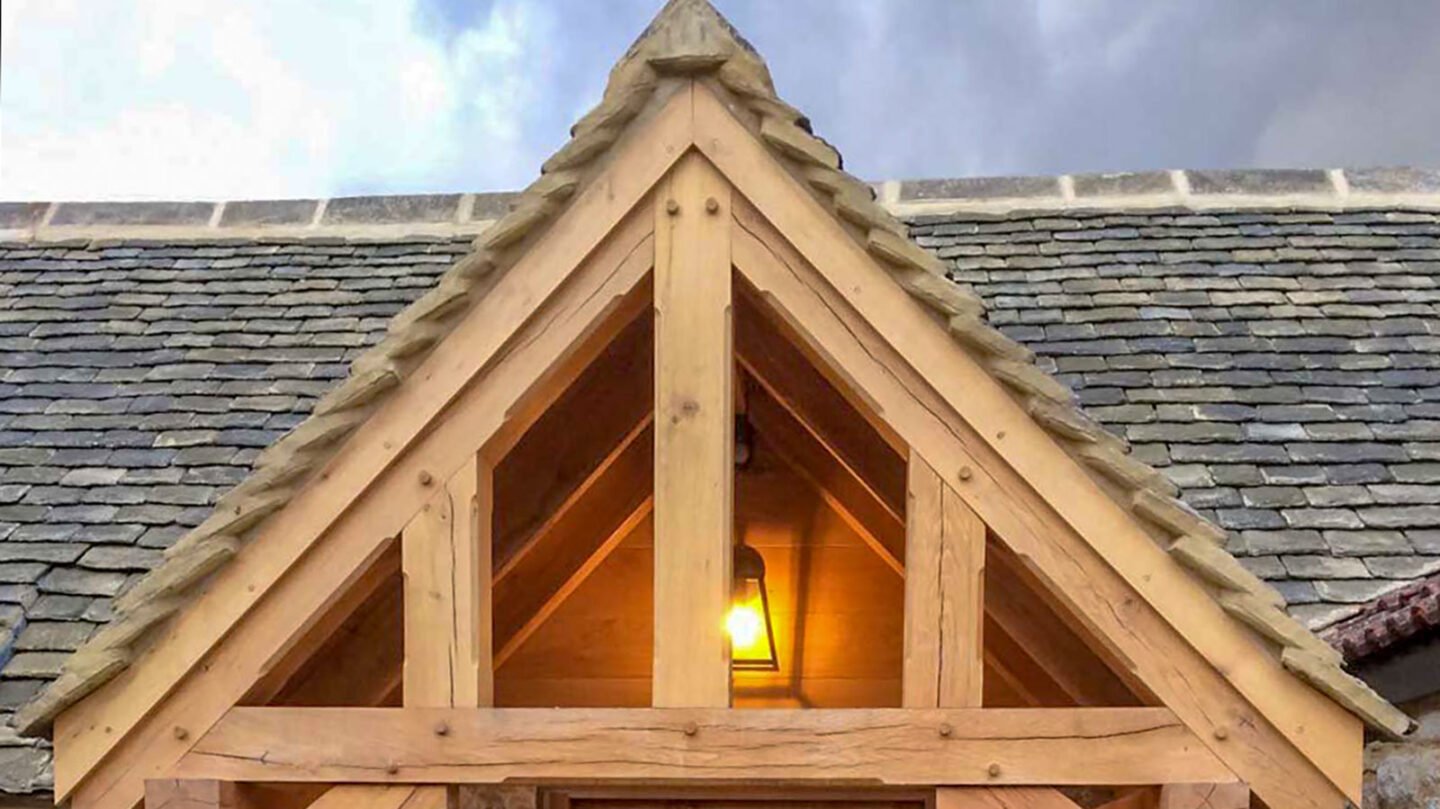
oakbydesign
01423 593 794


Oak By Design received a series of photo’s from their clients, David and Jade Shepherd. They had previously ordered an oak porch from them some time ago.
At the time they had been searchingoak porches and came across a photo of a porch supplied in the same area of the country.
They were in the process of converting a Grade 2 Listed Farmhouse in Oxfordshire, in The Cotswolds. The addition of an oak porch was only a small part of the full works.
An old coal shed was to be rebuilt and the oak porch was to be used as an inviting entrance. A blue slate roof to match the rest of the property would complement the porch.
After discussions over design, size and finish, Joanne sent a detailed quotation along with a drawing of their oak porch. The photos below capture the transformation of the property over a series of weeks and months.
It became a family affair as everyone helped in the renovation and installation of the oak porch. There were 2 small ‘L’ shaped dwarf walls at 600mm high for the sides of the porch to form an entrance at the front. The tops of the walls have brilliant white chamfered limestone capping stones. This is a lovely contrast against the oak and finishes off the wall beautifully.
The oak posts that sit on the wall incorporate a stainless steel rod to their underside to slightly elevate them off the wall. This means any surface water can drain away easily away from the oak.
Six curved brackets were added to the porch: two to the face of the porch and two at each side resulting in an arched window effect to the sides!. There were fascias for the front of the oak truss and oak over boarding sat on the rafters. When looking up underneath the roof, oak tongue and grooved boarding is visible.
As building the porch was against a single storey building, the ridge provided for the roof needed to be longer than the depth of the porch. As a result, the extended ridge would sit within the roof of the existing building. The oak porch and surrounding areas became one as the slate roof joined them together for a seamless finish.
David and Jade also chose to board the small triangular void area above the door. They used the same oak boards.
When Jade sent over the finished porch photo’s she said: ‘We love our porch, and are so thrilled with it”.
We can see why - the family have made a stunning job. If you’re looking for a break in this beautiful area, take a look at the couple's website for their holiday cottages: http://www.grovefarmcotswoldcottages.co.uk/
David sent another photo to Oak by Design not long after the finished porch photos were sent. Waking during the night, he had looked over to the porch from the bedroom and had the pleasure of seeing a barn owl fly into the porch and sit awhile with another. He grabbed his phone and managed a quick photo!
The owls are obviously pleased with the porch too!
Oak porches have long been admired for their timeless beauty and exceptional durability. These structures, crafted from the finest oak timber, add a touch of elegance to any home while providing practical benefits that stand the test of time.
The craftsmanship involved in constructing an oak porch is truly remarkable. Each piece of timber is carefully selected for its quality and strength, ensuring that only the finest materials are used. The intricate joinery techniques employed by skilled craftsmen result in a seamless and sturdy structure that exudes sophistication.
One cannot help but be captivated by the natural beauty of oak porches. The rich tones and grain patterns of the wood create a warm and inviting atmosphere, making them a welcoming addition to any property. As sunlight filters through the open design, casting enchanting shadows on the floor, one is transported to a tranquil haven where nature seamlessly blends with architectural splendour.
In addition to their aesthetic appeal, oak porches also boast remarkable durability. Oak is known for its resistance to decay and insect damage, making it an ideal choice for outdoor structures that are exposed to the elements. With proper care and maintenance, an oak porch can withstand harsh weather conditions year after year without losing its charm or structural integrity.
In conclusion, oak porches offer both visual delight and functional longevity. Their exquisite craftsmanship combined with their inherent strength make them an investment worth considering for those seeking to enhance their homes with enduring elegance.
Green oak and air-dried oak are two distinct types of timber commonly used in the construction industry. Understanding their characteristics is essential for any building expert.
Green oak, obtained from freshly felled trees, typically contains a high moisture content ranging from 60% to 80%. As the oak undergoes seasoning, a natural drying process, its moisture content gradually decreases. Seasoning can occur through air drying or kiln drying methods. However, in this discussion, we will focus on air-dried oak.
Air-dried oak is cut to size and left outside to dry naturally over time. During this period, proper air circulation between the timbers aids in reducing the moisture content. On average, air-dried oak dries at a rate of approximately 25mm per year. The duration of seasoning for air-dried oak depends on its thickness and can range from three to ten years.
One notable advantage of air-dried oak over green oak is its lower moisture content. This reduced moisture level makes air-dried oak more stable and less prone to movement and shrinkage compared to green oak. Consequently, using air-dried timber in construction projects minimises the risk of warping or cracking due to changes in humidity levels.
Moreover, because green oak contains higher levels of moisture, it may continue to shrink as it dries out after installation into a structure. This ongoing shrinkage can lead to gaps appearing between joints or connections within the building elements.
In summary, while both green oak and air-dried oak have their applications in construction projects, understanding their characteristics is crucial for selecting an appropriate timber type based on factors such as stability and resistance to movement or shrinkage during use.
Telephone: 01423 593 794
Locksley Park
Blind Lane
Tockwith
YORK YO26 7QJ
Opening Times:
Mon to Fri - 9.00am to 5.00pm
Bank Holidays - Closed
Christmas 2025- TBC
Oak By Design is the trading name of:
Oak By Design Ltd.
Reg Number: 04384416
VAT Number: 664 8012 33